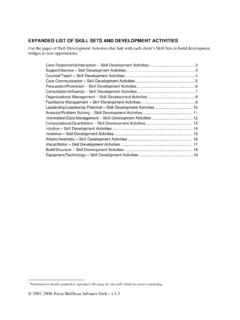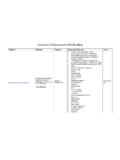Transcription of Exploring the Foundations of Explicit Instruction
1 1 In the quest to maximize students academic growth, one of the best tools avail-able to educators is Explicit Instruction , a structured, systematic, and effective methodology for teaching academic skills. It is called Explicit because it is an unambiguous and direct approach to teaching that includes both instructional design and delivery procedures. Explicit Instruction is characterized by a series of supports or scaffolds, whereby students are guided through the learning process with clear statements about the purpose and rationale for learning the new skill, clear explanations and demonstrations of the instructional target, and supported practice with feedback until independent mastery has been achieved.
2 Rosenshine (1987) described this form of Instruction as a systematic method of teaching with emphasis on proceeding in small steps, checking for student understanding, and achieving active and successful participation by all students (p. 34).In this chapter, we establish the foundation for the remaining chapters by Exploring the following topics: (1) elements of Explicit Instruction , (2) the under-lying principles of effective Instruction , and (3) the research evidence support-ing Explicit Instruction . We also respond to possible concerns about an Explicit approach to EmEnts of Explicit instructionEducational researchers ( , Brophy & Good, 1986; Christenson, Ysseldyke, & Thurlow, 1989; Gersten, Schiller, & Vaughn, 2000; Hughes, 1998; Marchand- Exploring the Foundations of Explicit InstructionChaptEr 1 From Explicit Instruction : Effective and Efficient Teaching by Anita L.)
3 Archer and Charles A. Hughes. Copyright 2011 by The Guilford Press. All rights reserved. 2 Explicit INStr UCtION Martella, Slocum, & Martella, 2004; Rosenshine, 1997; Rosenshine & Stevens, 1986; Simmons, Fuchs, Fuchs, Mathes, & Hodge, 1995; Swanson, 2001) have identified a range of instructional behaviors and elements characteristic of an Explicit approach to teaching. These 16 instructional elements are listed and briefly described in Fig-ure They are illustrated in more detail in subsequent chapters of this GurE Sixteen elements of Explicit Focus Instruction on critical content.
4 Teach skills, strategies, vocabulary terms, concepts, and rules that will empower students in the future and match the students instructional needs. 2. Sequence skills logically. Consider several curricular variables, such as teaching easier skills before harder skills, teaching high- frequency skills before skills that are less frequent in usage, ensuring mastery of prerequisites to a skill before teaching the skill itself, and separating skills and strategies that are similar and thus may be confusing to students. 3. Break down complex skills and strategies into smaller instructional units.
5 Teach in small steps. Segmenting complex skills into smaller instructional units of new material addresses concerns about cognitive overloading, processing demands, and the capacity of students working memory. Once mastered, units are synthesized ( , practiced as a whole). 4. Design organized and focused lessons. Make sure lessons are organized and focused, in order to make optimal use of instructional time. Organized lessons are on topic, well sequenced, and contain no irrelevant digressions. 5. Begin lessons with a clear statement of the lesson s goals and your expectations.
6 Tell learners clearly what is to be learned and why it is important. Students achieve better if they understand the instructional goals and outcomes expected, as well as how the information or skills presented will help them. 6. Review prior skills and knowledge before beginning Instruction . Provide a review of relevant information. Verify that students have the prerequisite skills and knowledge to learn the skill being taught in the lesson. This element also provides an opportunity to link the new skill with other related skills. 7. Provide step-by-step demonstrations.
7 Model the skill and clarify the decision- making processes needed to complete a task or procedure by thinking aloud as you perform the skill. Clearly demonstrate the target skill or strategy, in order to show the students a model of proficient performance. 8. Use clear and concise language. Use consistent, unambiguous wording and terminology. The complexity of your speech ( , vocabulary, sentence structure) should depend on students receptive vocabulary, to reduce possible confusion. 9. Provide an adequate range of examples and non- examples.
8 In order to establish the boundaries of when and when not to apply a skill, strategy, concept, or rule, provide a wide range of examples and non- examples. A wide range of examples illustrating situations when the skill will be used or applied is necessary so that students do not underuse it. Conversely, presenting a wide range of non- examples reduces the possibility that students will use the skill Provide guided and supported practice. In order to promote initial success and build confidence, regulate the difficulty of practice opportunities during the lesson, and provide students with guidance in skill performance.
9 When students demonstrate success, you can gradually increase task difficulty as you decrease the level of guidance. (cont.) the Foundations of Explicit Instruction 3As noted earlier, effective and Explicit Instruction can be viewed as providing a series of instructional supports or scaffolds first through the logical selection and sequencing of content, and then by breaking down that content into manageable instructional units based on students cognitive capabilities ( , working memory capacity, attention, and prior knowledge). Instructional delivery is characterized by clear descriptions and demonstrations of a skill, followed by supported prac-tice and timely feedback.
10 Initial practice is carried out with high levels of teacher involvement; however, once student success is evident, the teacher s support is sys-tematically withdrawn, and the students move toward independent performance. The 16 elements of Explicit Instruction can also be combined into a smaller number. Rosenshine and Stevens (1986) and Rosenshine (1997) have grouped these teaching elements into the six teaching functions outlined in Figure GurE (cont.) 11. Require frequent responses. Plan for a high level of student teacher interaction via the use of questioning.








